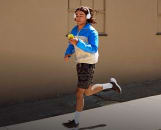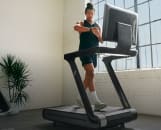
RoxiRosita / Moment via Getty Images
Why Your Dreams May Feel More Vivid After Exercising
There’s a few reasons why your dreams may feel more bizarre or intense after amping up your workout routine.
By Anna Medaris•
Having Bizarre Dreams After Starting the Gym? Here’s What May Be Happening
How Long Will These Vivid Dreams After Exercise Last?
Are Certain Types of Exercise More Prone to Triggering Vivid Dreams?
Is There Anything You Can Do to Quell Vivid Dreams After Exercise?
The Takeaway
If you’ve been doubling down on your workouts—maybe you’re training for a half marathon or embracing a new after-work gym routine—you probably expect to be a little hungrier, less stressed, and a bit sore.
But what you might not anticipate is experiencing vivid dreams after exercise, though there are several reasonable theories as to why they can occur. Here’s what experts say may be driving those wild dreams after starting or advancing a training regimen, how long they could last, and whether you can—or should—make changes to tame them.
Having Bizarre Dreams After Starting the Gym? Here’s What May Be Happening
There’s not a lot of research specifically looking at how exercise affects the various stages of sleep—and therefore dreams—afterwards, says Michael Grandner, PhD, a licensed clinical psychologist and director of the Sleep and Health Research Program at the University of Arizona. But a few things could be going on:
1. You’re Getting More REM Density
Exercise, on the whole, is good for sleep—and vice versa, research shows. Consistent physical activity helps regulate your circadian rhythm, or your natural sleep-wake cycle, promoting deeper, more restorative rest, per the National Sleep Foundation.
But better exercise-induced sleep doesn’t necessarily mean more rapid eye movement or REM sleep, the stage when the most lively dreaming occurs.
In fact, says David Kuhlmann, MD, a spokesperson for the American Academy of Sleep Medicine, “exercise tends to, if anything, lessen the amount of REM sleep,” and instead maximizes the slow-wave, deep sleep that’s more closely tied to recovery.
So what’s going on? It’s possible that exercisers are getting more REM density—or more consolidated and efficient REM sleep —but not necessarily more time in that dream-laden phase, Dr. Kuhlmann says.
Grandner agrees. “When you’re sleep deprived, your hunger for sleep goes up and you get into it faster and you get into it harder,” just like you probably eat more and faster when you’re famished, he says. REM follows a similar system, he explains: When we don’t get enough REM sleep, our bodies fall into it quicker and more intensely when that stage finally comes around.
2. You’re Sleeping In Later
Wilder dreams could also be a function of timing. Since most REM sleep occurs in the second half of the night, you may be experiencing more of it if, for instance, you sleep in later to aid exercise recovery or to accommodate a new evening training plan.
“It’s sort of like the fruit at the bottom of the yogurt,” Grandner explains of REM sleep. “If you stop eating your yogurt halfway in, you never get to the fruit. But if all of a sudden you make it all the way down to the bottom, you think, ‘Oh my gosh, all of this fruit was here, who knew?’”
3. You’re Waking Up Earlier
The reverse could be true too: Perhaps your revamped routine involves waking up earlier to meet up with a run club or take your new favorite Peloton class. If your alarm goes off during the REM stage mid-dream, you’re simply more likely to remember it. “It might just be that you’re noticing your dreams more because you’re interrupting them more often,” Grandner says.
4. Your Brain Is Making Sense of the Change
Often, when you make a change—be it a big one like moving across the country or a smaller one like picking up Pilates—your brain helps to process it through dreams, Grandner says. “Your body and your brain are learning how to integrate it into your life, how to do it better, and how to learn from mistakes, how to learn from success,” Grandner says. “When you change things up, it shows up in your dreams.”
5. You’re Forming New Health Habits
Maybe your beefed-up fitness plan has inspired other shifts, like drinking less alcohol or cutting out cannabis. Both substances can disrupt sleep and dreaming; with less or none of them, your dreaming may rebound, Grandner hypothesizes.
Alcohol, for instance, has been shown to delay the first REM cycle and reduce the amount of REM sleep overall. And a 2023 study in the Journal of Clinical Sleep Medicine found long-term use of cannabis decreases slow-wave sleep.
Adding substances like supplements to the mix can make a difference too. For example, if you’re popping melatonin before bed to spur sleep after an evening workout, you may be fueling your vivid dreams. “Every time I speak to people who tell me they’re taking melatonin, I ask if they’re having wild dreams and nightmares,” says Whitney Roban, PhD, a clinical psychologist, author, and founder of the sleep-training program Solve Our Sleep. “Most people will say, ‘yeah.’” (Remember: It’s always a good idea to speak with your healthcare provider before trying any new supplements.)
Related Articles

Sleep
How to Decode the Best Bedtime for You (and 4 Tips for Actually Sticking to That Time)

Sleep
Everyone Benefits from a Bedtime Routine. Here’s How to Build One You’ll Actually Stick With

Sleep
Which Is Better for Sleep: A Hot or Cold Shower Before Bed?

Sleep
What Is Revenge Bedtime Procrastination, and How Can You Quit Doing It?
How Long Will These Vivid Dreams After Exercise Last?
It’s hard to say. How long these wild dreams will last depends in part on why they started, and as we’ve learned, a host of factors could be at play. But, just like your muscles adjust to that extra weight on the barbell, your brain will likely adjust to your new fitness routine—if it becomes your norm. “We dream about the things that we’re working on, and if it’s not something we’re working on, integrating, or figuring out, then it won’t show up in dreams,” Grandner says.
Are Certain Types of Exercise More Prone to Triggering Vivid Dreams?
Again, anything new to you is more likely to wind up as dream fodder for your brain. So a longtime cyclist may find themselves dreaming more vividly after picking up ballet, and a lifelong swimmer might wrestle with bizarre dreams after an injury keeps them out of the pool.
But we don’t really know how various types of exercises affect REM sleep, Dr. Kuhlmann says. What we do know, though, is that aerobic exercise can increase the size of the anterior hippocampus, the part of the brain involved in memory and imagination. And, given the extent to which detailed dreams require those processes, aerobic exercise may be linked to more vivid dreams, Dr. Kuhlmann posits.
Is There Anything You Can Do to Quell Vivid Dreams After Exercise?
First, try not to worry about it too much: Dreams, in general, are thought to be a good sign. More information is needed, but researchers have historically theorized that they help the brain “unlearn” unhelpful or unwanted thoughts or information (therefore staving off troublesome worries during the day, for one), and help you rehearse situations you don’t typically encounter during the day.
The deep sleep that dominates the first half of the night prunes information from the day, sort of like you might clean out your fridge—and then REM gets creative cooking with what fresh food is left over, Grandner says. “REM sleep is taking what’s left that you’ve sorted and organized and kept…and works with it, thinks about it, turns it over, examines it, integrates it, questions it,” he says.
Still, if your dream life is largely disruptive or disturbing to you, work on improving your sleep hygiene. That could look like taking time to wind down before bed (sans screens) and scheduling worry time during the day, the Cleveland Clinic suggests. You could also take a soothing meditation class on the Peloton App to help your brain relax before hitting the hay.
Still struggling? It’s worth seeking the help of a specialist like a sleep-medicine doctor. “If you find yourself having nightmares, that could be a sign of an underlying sleep disorder,” Dr. Kuhlmann says. “If you’re finding that you’re not dreaming at all, that can be a sign of underlying sleep disorders.”
The Takeaway
It’s probably not unusual to experience more vivid dreams after amplifying your exercise routine, and there’s several theories as to why. It could have to do with experiencing a higher density of REM sleep, or experiencing more REM sleep if your new routine involves a later wake time. Or, it could have little to do with exercise and instead stem from other new habits that correspond with your revamped workout routine, like skipping happy hour.
“Sleep is something that we’ve really just been studying recently, and there’s so much we don’t know,” Roban says. “Not every question about sleep actually has an answer.”
But intensified dreaming isn’t usually something to worry about, and can be a sign of healthy brain function. Enjoy the show!

Peloton App
Access thousands of classes with no equipment needed.
This content is for informational and educational purposes only and does not constitute individualized advice. It is not intended to replace professional medical evaluation, diagnosis, or treatment. Seek the advice of your physician for questions you may have regarding your health or a medical condition. If you are having a medical emergency, call your physician or 911 immediately.
Get your best Zzzs yet
Enter your email to get articles, expert-backed tips, and updates from Peloton sent to your inbox.
By providing your email address, you agree to receive marketing communications from Peloton.
For more about how we use your information, see our Privacy Policy.






